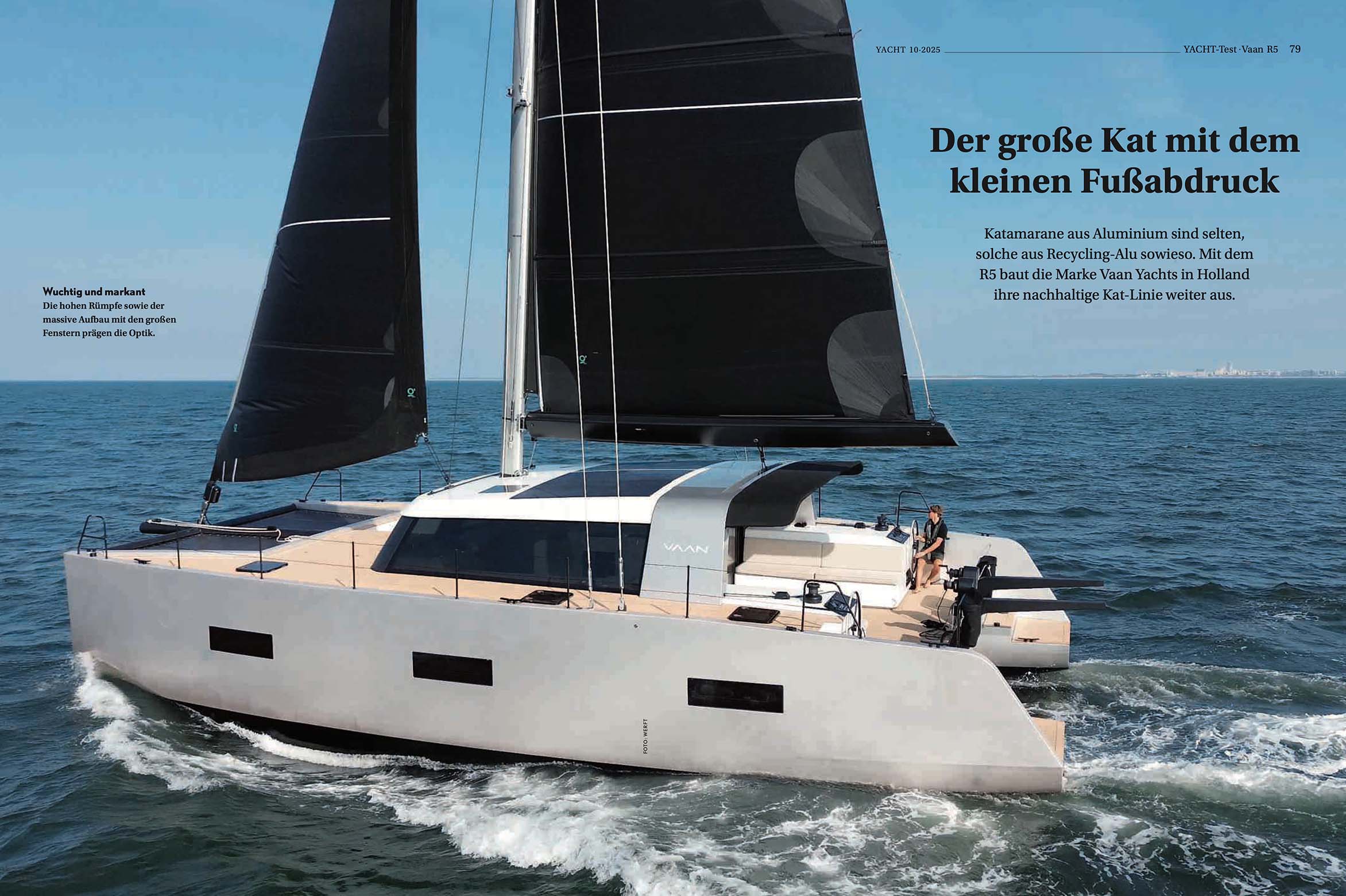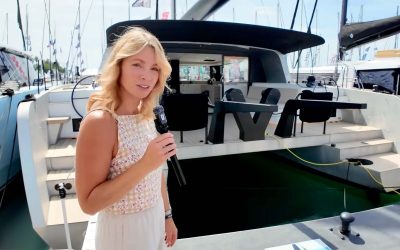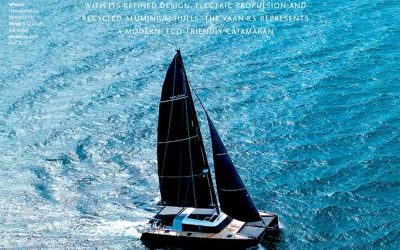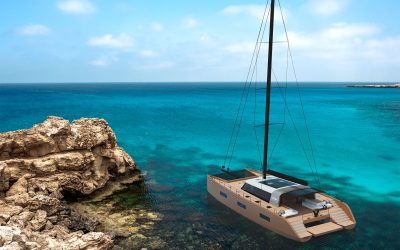Vaan R5 review by Yacht Magazine
‘ The big cat with the small footprint’, what a great title for Michael Good’s windy test sail of the R5 for Yacht Magazine. Read his test below in english.
THE BIG CAT WITH THE SMALL FOOTPRINT
Aluminium catamarans are rare, and those made of recycled aluminium are rare. With the R5, the Vaan Yachts brand in Holland is expanding its sustainable cat line.
BY: Michael Good for Yacht Magazine – Translation by Vaan Yachts
All rights reserved and copyright Delius Klassing / Yacht Magazine
Photos by B. Kolthof & Vaan Yachts
Full article/magazine can be purchased via https://www.yacht.de/en/
Aluminium is an excellent building material. Aluminium is light, extremely strong, can be formed without stress and is also corrosion-resistant. And in the event of a collision, the aluminium hull will have dents rather than holes, which is easy to repair. The advantages for yacht building are obvious.
Nevertheless, yachts made of light metal are generally considered to be among the exotics on the market. But why? First and foremost, aluminium is much more expensive than fibreglass or wood and more costly process than steel, for example. The material is also very susceptible to electrochemical processes (electrolysis) and must therefore be consistently separated from other metals. In yacht construction with aluminium, this is one of the major challenges. And not lastly, the production of aluminium requires indecent amounts of energy.
And this is precisely where the ambitious concept of Vaan Yachts in Holland comes in, because aluminium can be recycled as often as you like without compromising on quality. The recycling process requires only about five percent of the energy needed to produce the raw material, which is why Vaan Yachts builds its catamarans exclusively from recycled and refined aluminium (see shipyard report, p. 85). But that’s not all. Vaan is also uncompromising in its use of sustainable technologies and renewable materials. The young brand’s catamarans are equipped with electric motors throughout, the deck is covered with cork instead of teak and the interior is lined with panels made from recycled PET bottles. These are just a few examples of the many measures taken in this direction.
Vaan Yachts ventured into the market with the R4 only three years ago. The 13-metre cat was featured on test in YACHT 8/2023. Four boats of this type have already been delivered and two more are now under construction. Now Vaan is presenting the R5, the upward extension of the line. The special concept and construction method are retained, the boat has essentially only become larger and can be extended in variants with up to four double cabins. In addition, the shipyard, based in Hellevoetsluis near Rotterdam, already has plans an R6 with an 18-metre hull length and a 24-metre R8 as projects ready to go.
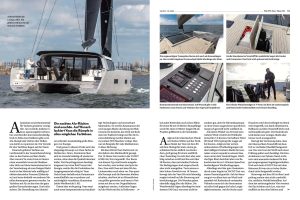
Due to gale force winds and high waves in the North Sea, the test with the R5 on the Haringvliet, a protected area south of Rotterdam, large enough for an extensive test drive. The winds are gusting from twelve to well over 20 knots, with strong gusts, and the conditions are challenging but not unsailable. Despite its relatively high weight of 19 tonnes, the Vaan R5 moves quite lively, responds quickly to the steering and accelerates well.
Turns are also quick. However, the turning angles are 100 degrees, which is not particularly good, but not unusual for cruising catamarans without a proven sporting ambition. At an angle of 50 degrees to the true wind the Dutchman reaches 7.2 knots, and at half wind (90 degrees TWA) the log jumps to 8.4 knots. Due to the extremely unconstant wind conditions with the strong pushers, the gennaker remains packed in its stowed position for the time being. However, yard manager Igor Kluin reports record speeds of up to 14 knots in more consistent wind conditions.
However, the good overall impression under sail in the YACHT test is effected by one fact: there is an unacceptable high amount of rudder pressure on the steering, especially hard upwind. In fact, the helmsman has to fight the high windward yaw with all his might. To find the cause, the mainsail is reefed a little, which is easy to do with the touch of a button thanks to the electric furling boom on the test boat. This reduces the rudder pressure, but it is still unpleasant. This suggests that the mast on the test vessel is set with far too much rake (mast halyard). The designs of Dykstra Naval Architects are otherwise known for their well-balanced sailing characteristics. And the YACHT test with the smaller R4 also failed to detect excessive rudder pressure.
[NOTE VAAN: The rudder pressure during the test sail was caused by freshly installed sail protection on the stays as the R5 was departing the next morning to La Grande Motte. The rigging was not yet trimmed after this installation, and has since been stabilised.]
On the way with the R5, a not inconsiderable lateral drift is also detectable by means of a land bearing. On the almost current-free Haringvliet, the cat is visibly shifted to leeward, presumably due to the rather small and slender stubby keels on which the cat can easily be beached. But the shipyard already has a solution to this problem. As an option, the keels can as an option be fitted with integral daggerboards can be electrically retracted and extended at the touch of a button. With this additional lateral surface, drift should then be significantly reduced.
As a special feature, the shipyard builds a V-shaped winch station on the stern of all the cats. On the test boat, the two horizontally installed winches can be operated at the push of a button on the steering position. The jib sheet, halyards and reefing lines can be operated from here. For the traveller and the main sheet additional winches are placed on the deck in front of both steering wheels, which can also be operated electrically if required. The handling clear and easy, even in one-handed mode, thanks to the self-tacking jib. An overlapping genoa is not offered as an option.
[NOTE VAAN: A code-0 and gennaker are available as options.]
The helmsman stands relatively low behind the wheels on the sides, but still has a good view into the sails, and also forward in the direction of travel thanks to the almost continuous glazed cabin superstructure. However, the helmsman needs support and announcements from the crew for the docking and departure manoeuvres in port. To enable him to change sides, a second motor control on the port side of the helm station is recommended.
[NOTE VAAN: The test boat is equiped with such second control; both helm stations are complete copies. The helmsman can be on either side for full 360 views.]
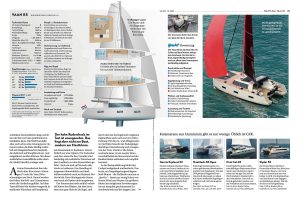
In the standard version, the cockpit remains largely unroofed, with the short fabric bimini – the Dutch call it a “spoiler” – attached to the roll bar offering little protection from sun, wind and water. A larger bimini with possible extensions up to a completely enclosed cockpit is on the long list of possible options. Thanks to the construction In addition, the shipyard is also receptive to any special requests from customers.
In the saloon, the Vaan R5 surprises with an open and rather sober interior. This is complemented by a highly functional layout with the seating area and lowerable table on the one hand, and the huge pantry with large work surfaces and ample storage space on the other. There’s not much more to it than that.
What stands out are the huge, almost uninterrupted windows in the superstructure, allow a magnificent all-round view. Because aluminium catamarans hardly warp even in rough seas, Vaan can use long windows with real double glazing. They offer perfect sound and temperature insulation. In fact, the saloon is wonderfully quiet even at sea.
For the extension, three or four-cabin versions are possible, but both versions have only two toilet compartments, each with an additional very spacious and separate shower room.
[NOTE VAAN: This is incorrect, the 4 cabin version has 3 toilets. 2x in the PS hull cabins and 1 shared in the guest hull]
Vaan builds boats primarily for owners and not for the charter business. From this point of view, the number of wet rooms is not relevant, but their functionality is even more so. The interior is generally beautifully built, down to the last detail. The plywood components are either covered with real wood or laminates in all possible colours.
The customer can therefore also choose the look below deck to suit his or her taste. In addition to the good workmanship, the many possibilities for ventilation in all living areas and the many easily accessible storage spaces are also pleasing. The dissolution comes with an upmarket base price of just under EUR 1.78 million gross for the Vaan R5 in the basic version ex shipyard. This is undoubtedly a lot of money for a catamaran of this size. However, it is difficult or impossible to price the boat in a possible competitive environment, because there are directly comparable there are no ships with similar concepts.
[NOTE VAAN: The stated price is including VAT. To compare, the base price ex VAT is €1.495.000,-]
CONCLUSION
The Vaan R5 is a boat for a life on the water with a good conscience. The cat is robust, independently designed and one thing above all: consistently sustainably built.
Construction and concept
+ Sustainable construction
+ Robust aluminum construction
– High price in comparison
Sailing performance and trim
+ Agile sailing characteristics
+ Single-handed handling
– Lot of drift upwind
– High rudder pressure (test boat, see note above)
Living and finishing quality
+ Beautiful workmanship
+ High sleeping comfort aft
+ Many usable storage spaces
Equipment and technology
+ Electric motors as standard
+ High-quality equipment
+ Cardanic steering
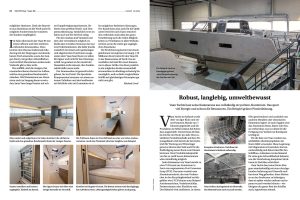
Robust, durable, environmentally responsible
Vaan Yachts builds its catamarans from completely recycled aluminium, which saves a lot of energy and conserves resources. An example of green pioneering.
Vaan Yachts in Holland was founded with partner Nienke van ‘t Klooster and production is based in Hellevoetsluis near Rotterdam. The brand currently builds three to four boats a year. An additional production hall on the company’s premises is currently as a service facility for maintenance and winter storage, but could soon be used for the final production of new boats. A production capacity up to twelve new catamarans would possible in the medium term.
Each Vaan catamaran is made up of about 75 percent aluminium in the form of post consumer scrap (PCS), which is aluminium scrap that is to the recycling loop by the consumer. PCS can be, for example, car number plates, road signs, window frames or similar items. Material is shredded, melted in a furnace and then alloyed with other metals or chemical elements to make the aluminium stronger, harder or more malleable, depending on what is added, which is particularly important for the production of yachts in round frames.
Finally, Vaan’s cats use aluminium plates of standard 5083, an alloy with magnesium that is particularly resistant to corrosion and therefore ideal for shipbuilding. The material is also known for its good weldability, facilitates the fabrication of complex structures in yacht building. Vaan Yachts, incidentally, builds its boats with continuous glass wool insulation as standard and has found a way to attach these mats to the structures in such a way that they can be removed later and recycled separately – like for that matter, the rest of the ship too, at some point.
PHOTO CAPTIONS:
P78: Massive and striking The high hulls and the massive superstructure with its large windows characterise the look.
P80: Aft, the cockpit remains open. A larger bimini is available on request.
P81: The close-meshed trampolines also make sun loungers, although the recessed front cockpit remains very small.
P81: Large storage spaces in the forepeak for extra sails, all fenders and mooring lines. The deck is optionally covered with cork.
P81: Command centre at the helm. On request, all functions for setting and trimming the sails are available at the touch of a button.
P81: The robust V-shaped winch carrier at the rear is typical of the brand and offers high functionality and excellent handling.
P84: Clear, clean and tidy. The saloon is dominated by a sober look and a magnificent panoramic view thanks to the huge windows.
P84: The Pullmann berths in the foredeck are just one of many options. A workshop would also be possible here, for example.
P84: Neatly installed and easily accessible, electrics in the box.
P84: Owners will be delighted with a huge wet room in the foredeck.
P84: Comfort in a king-size format. The beds aft are almost 1.80 metres wide throughout. There is also plenty of ventilation.
P85: The hulls are built in round frames, a challenge for building with aluminium.
P85: Complex structures. Yacht building with aluminium is extremely complex.
P85: Vaan insulates throughout with glass wool. The material can also be recycled.
OTHER POSTS:
Vaan R5 tour by German Television
Jeanne Herzog from German Television tours the Vaan R5
Yachting World tests the Vaan R5
Sail test of the Vaan R5 by the world’s leading sailing magazine.
Vaan R8 featured in ‘Super Cat’ article
Recently the upcoming Vaan R8 was featured as one of the Super Cats to watch.
